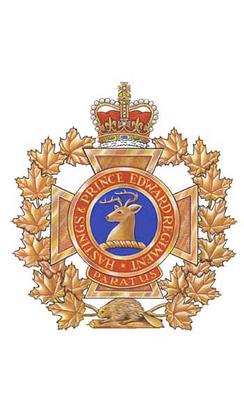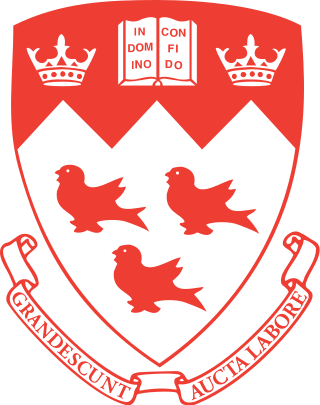
Saint-Jean-sur-Richelieu is a city in eastern Montérégie in the Canadian province of Quebec, about 40 kilometres (25 mi) southeast of Montreal, located roughly halfway between Montreal and the Canada–United States border with the state of Vermont. It is situated on both the west and east banks of the Richelieu River at the northernmost navigable point of Lake Champlain. As of December 2019, the population of Saint-Jean-sur-Richelieu was 98,036.

The Royal Military College Saint-Jean, commonly referred to as RMC Saint-Jean and CMR, is a Canadian military college and university. It is located on the historical site of Fort Saint-Jean, in Saint-Jean-sur-Richelieu, Quebec, 40 km south of Montreal. RMC Saint-Jean is an arm of the Canadian Military College (CMC) system that provides two college-level programs in Social Science and Science, which are closely integrated with the undergraduate programs offered by the Royal Military College of Canada. RMC Saint-Jean was granted independent university status in 2021, and it currently offers a bachelor's degree in International Studies.

The 4th Canadian Division is a formation of the Canadian Army. The division was first created as a formation of the Canadian Corps during the First World War. During the Second World War the division was reactivated as the 4th Canadian Infantry Division in 1941 and then converted to armour and redesignated as the 4th Canadian (Armoured) Division. Beginning in 1916 the division adopted a distinctive green-coloured formation patch as its insignia. In 2013 it was announced that Land Force Central Area would be redesignated 4th Canadian Division. It is currently responsible for Canadian Army operations in the Canadian province of Ontario and is headquartered at Denison Armoury in Toronto.

The Royal Canadian Hussars (Montreal) (abbreviated as RCH) is an armoured reconnaissance regiment of the Primary Reserve in the Canadian Armed Forces. It is one of the oldest cavalry regiments in North America, tracing a direct history to the Montreal Volunteer Cavalry formed in the late eighteenth century. Its Colonel-in-Chief is Her Royal Highness, the Princess Royal, and its allied regiment is the Queen's Royal Hussars. Its mission consists of supporting the Regular Force in operational deployments, peacetime tasks, and supporting the civilian authorities.

Brigadier-General Charles Mills "Bud" Drury was a Canadian military officer, lawyer, civil servant, businessman and politician.

The Hastings and Prince Edward Regiment is a Primary Reserve infantry regiment of the Canadian Army. The regiment is part of 33 Canadian Brigade Group, one of four brigade groups of 4th Canadian Division. The regimental headquarters and one company are at 187 Pinnacle Street in Belleville and on Willmott Street in Cobourg, with another rifle company in Peterborough. The Peterborough Armoury houses what was traditionally B Company or Moro Company. Moro Company also serves as the headquarters for the regiment’s Assault Pioneer Platoon. Normally, the regiment deploys as a composite, Ortona Company, while the headquarters and administration form Somme Company.

The Royal Canadian Horse Artillery is the name given to the regular field artillery units of the Canadian Army.
2nd Canadian Division Support Base Valcartier, Detachment Montreal, formerly known as and commonly referred to as Canadian Forces Base Montreal is a Canadian Forces Base network located in Montreal, Quebec. The address of CFB Montreal is 6769 Notre-Dame Street.

Jacques Duchesneau, is a Canadian politician, civil servant, former chief of police, and former president and chief executive officer of the Canadian Air Transport Security Authority. Duchesneau was a member of the Quebec National Assembly for the riding of Saint-Jérôme from 2012 to 2014, elected under the Coalition Avenir Québec banner.

McGill University is an English-language public research university located in Montreal, Quebec, Canada. Founded in 1821 by royal charter, the university bears the name of James McGill, a Scottish merchant and slave owner, whose bequest in 1813 established the University of McGill College. In 1885, the name was officially changed to McGill University. The university has an enrolment of more than 39,000 students.
The 62nd Field Artillery Regiment, RCA is a militia unit of the Canadian Army that has its own military band and is located in Shawinigan, Quebec. It recruits primarily in Shawinigan, Joliette and Victoriaville.

Fort Saint-Jean is a fort in the Canadian province of Quebec located on the Richelieu River. The fort was first built in 1666 by soldiers of the Carignan-Salières Regiment of France who had travelled to New France to assist the young colony. It was part of a series of forts built along the Richelieu River. Over the years, it was destroyed and rebuilt several times, but it is, after Quebec City, the military site that has been occupied non-stop for the longest time in Canada. The fort is designated as a National Historic Site of Canada, and it currently houses the Royal Military College Saint-Jean. The fort has been continually occupied since 1748, and is the core from which the city of Saint-Jean-sur-Richelieu, Quebec grew around. Fort Saint-Jean played a crucial role in the British defense strategy during the 1775 American invasion of the Province of Quebec.

Major General William Henry Pferinger Elkins, was a Canadian soldier. He was a commandant of the RMC.
Lieutenant General Jacques Chouinard CMM CD was the Commander, Mobile Command of the Canadian Forces.

The following outline is provided as an overview of and topical guide to Quebec:

Joseph André Horace Jean Berthiaume, OBE, CD was a Canadian Army officer who served with the Régiment de St-Hyacinthe, the Royal Canadian Infantry Corps and the Royal 22e Régiment.
Brigadier C.S. Thompson OBE, CD, was the 15th Canadian Surgeon General.
The Canadian Officers' Training Corps (COTC) was, from 1912 to 1968, Canada's university officer training programme, fashioned after the University Officers' Training Corps (UOTC) in the United Kingdom. In World War Two the Canadian Army was able to produce quality officers due to the high standards of the COTC.

Brigadier General F.G. Carpentier, CD is currently the Canadian National Military Representative to Supreme Headquarters Allied Powers Europe. He previously was the commanding officer of the 2nd Canadian Division, a position he has held from 2019 to 2021.
The New Brunswick Dragoons was a cavalry regiment of the Non-Permanent Active Militia of the Canadian Militia. In 1936, the regiment was Amalgamated with The Saint John Fusiliers.















